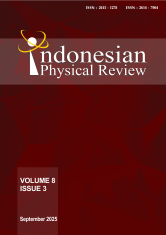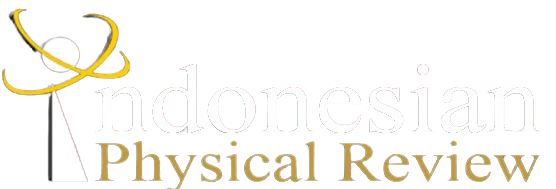SOLUTION OF THE TIME-INDEPENDENT SCHRÖDINGER EQUATION FOR THE ROSEN–MORSE POTENTIAL BY USING THE GALERKIN METHOD
DOI:
10.29303/ipr.v8i3.492Downloads
Abstract
This study presents a numerical solution to the time-independent Schrödinger equation (TISE) for the Rosen-Morse potential using the Galerkin method. The Rosen-Morse potential, commonly used in atomic and molecular physics, has known analytical solutions under certain conditions. By transforming the TISE into a Jacobi differential equation, the analytical wave function and energy levels can be derived. However, analytical solutions are limited to ideal cases, highlighting the need for numerical methods in more general scenarios. The Galerkin method is implemented by expanding the wave function using Sine basis functions and projecting the TISE onto this basis. The resulting eigenvalue problem is solved by constructing the Hamiltonian matrix from kinetic and potential energy operators. Numerical results from the Galerkin method are compared with analytical solutions using graphical analysis, percentage error (% error), and statistical tests, including the Mann-Whitney U test. The results demonstrate that the probability densities obtained using the Galerkin method closely approximate the analytical solution. This is visually evident from the overlapping of probability density plots from both methods. The percentage error of the probability densities is below 1 %, entirely. Furthermore, the Mann–Whitney U test yields a p-value less than 0.05, indicating that the differences between the two sets of probability densities are statistically insignificant at the 95% confidence level. These findings highlight the Galerkin method’s effectiveness and accuracy as a robust numerical tool for solving the TISE with the Rosen-Morse potential.
Keywords:
Schrödinger Equation Rosen-Morse Potential Galerkin MethodReferences
[1] M. E. Udoh and U. S. Okorie, “Rotation-vibrational energies for some diatomic molecules with improved Rosen–Morse potential in D-dimensions,” J. Mol. Model., vol. 25, no. 170, pp. 1–7, 2019.
[2] G. Gordillo-núñez, R. Alvarez-nodarse, and N. R. Quintero, “The Schrödinger equation for the Rosen-Morse type potential revisited with applications,” pp. 1–26, 2023, [Online]. Available: https://arxiv.org/abs/2304.06730
[3] A. Khodja, A. Kadja, F. Benamira, and L. Guechi, “Path integral solution for a Klein-Gordon particle in vector and scalar deformed radial Rosen-Morse-type potentials,” Indian J. Phys., vol. 91, pp. 1561–1569, 2017.
[4] M. Al-raeei, “The bond length of the improved Rosen Morse potential , applying for : Cesium , hydrogen , hydrogen fluoride , hydrogen chloride , lithium , and nitrogen molecules,” Results Chem., vol. 4, no. January, pp. 1–7, 2022.
[5] G. Gordillo-núñez, R. Alvarez-nodarse, and N. R. Quintero, “The complete solution of the Schrödinger equation with the Rosen – Morse type potential via the Nikiforov – Uvarov method,” Phys. D Nonlinear Phenom., vol. 458, no. October 2023, p. 134008, 2024.
[6] E. C. Romão, M. D. Campos, and L. F. M. Moura, “Application of the Galerkin and Least-Squares Finite Element Methods in the solution of 3D Poisson and Helmholtz equations,” Comput. Math. with Appl., vol. 62, no. 11, pp. 4288–4299, 2011.
[7] D. F. Griffiths and J. Lorenz, “An Analysis of The Petrov-Galerkin Finite Element Method,” Comput. Methods Appl. Mech. Eng., vol. 14, no. 1, pp. 39–64, 1978.
[8] X. I. U. Ye and S. Zhang, “Numerical Investigation On Weak Galerkin Finite Elements,” vol. 72204, pp. 1–20, 2020, [Online]. Available: https://doi.org/10.48550/arXiv.2004.12483
[9] K. Nedaiasl and R. Dehbozorgi, “Galerkin Finite Element Method for Nonlinear Fractional Differential Equations,” Numer. Algorithms, vol. 88, pp. 113–141, 2020.
[10] M. Bachmayr, M. Eigel, H. Eisenmann, and I. Voulis, “A convergent adaptive finite element stochastic Galerkin method based on multilevel expansions of random fields,” pp. 1–24, Mar. 2024, [Online]. Available: https://doi.org/10.48550/arXiv.2403.13770
[11] V. F. Los and M. V. Los, “An exact solution of the time-dependent Schrodinger equation with a rectangular potential for real and imaginary time,” pp. 1–19, 2015, [Online]. Available: https://arxiv.org/abs/1509.02809
[12] B. Brumm, “A fast matrix-free algorithm for spectral approximations to the Schrödinger equation,” pp. 1–27, 2015, [Online]. Available: https://arxiv.org/abs/2307.13711
[13] S. M. Jung and B. Kim, “Perturbation of One-Dimensional Time Independent Schrödinger Equation With a Symmetric Parabolic Potential Wall,” Symmetry (Basel)., vol. 12, no. 7, 2020.
[14] A. Pakniyat and K. Parand, “Using hermite neural networks to solve the time-independent schrodinger equation,” Indian J. Phys., vol. 97, no. 12, pp. 3581–3587, 2023.
[15] S. Garneau-Desroches and V. Hussin, “Linking ladder operators for the Rosen-Morse and Pöschl-Teller systems,” in SciPost Physics Proceedings, Strasbourg, France: SciPost Foundation, 2023, pp. 1–9.
[16] A. D. Alhaidari, I. A. Assi, and A. Mebirouk, “Bound-states for generalized trigonometric and hyperbolic Pöschl-Teller potentials,” pp. 1–19, 2021, [Online]. Available: https://arxiv.org/abs/2108.08978
[17] A. N. Ikot and L. E. Akpabio, “Approximate Solution of the Schrödinger Equation with Rosen-Morse Potential Including the Centrifugal Term,” vol. 2, no. 2, pp. 202–208, 2010, [Online]. Available: https://ccsenet.org/journal/index.php/apr/article/view/6753
[18] E. I. Jafarov and S. M. Nagiyev, “Exact solution of the position-dependent mass Schr ¨ odinger equation with the completely positive oscillator-shaped quantum well potential,” pp. 1–11, 2023, [Online]. Available: https://arxiv.org/pdf/2212.13062
[19] E. O. Oghre, T. J. Taiwo, and A. N. Njah, “Solution of the Schrodinger equation using tridiagonal representation approach in nonrelativistic quantum mechanics : a Pedagogical Approach,” pp. 1–27, 2018, [Online]. Available: https://arxiv.org/pdf/1810.05509
[20] L. Boulton and G. J. Lord, “Basis properties of the p, q-sine functions,” Proc. R. Soc. A Math. Phys. Eng. Sci., vol. 471, no. 2174, pp. 1–28, 2015.
[21] Y. Luo, “Galerkin method with trigonometric basis on stable numerical differentiation,” Appl. Math. Comput., vol. 370, pp. 1–35, 2020.
[22] A. Secer, “Numerical solution and simulation of second-order parabolic pdes with sinc-galerkin method using maple,” Abstr. Appl. Anal., vol. 2013, 2013, [Online]. Available: https://onlinelibrary.wiley.com/doi/10.1155/2013/686483
[23] C. L. Morrison and B. Shizgal, “Pseudospectral solution of the Schrödinger equation for the Rosen-Morse and Eckart potentials,” J. Math. Chem., vol. 57, no. 4, pp. 1035–1052, Apr. 2019.
[24] M. Luo, D. Xu, and X. Pan, “Sinc-Galerkin method and a higher-order method for a 1D and 2D time-fractional diffusion equations,” Bound. Value Probl., vol. 2024, no. 1, 2024.
[25] D. J. Pine, Introduction to Python for Science and Engineering. New York, USA: CRC Press, 2019.
[26] I. G. A. Widagda, I. N. Artawan, W. G. Suharta, and I. G. A. Kasmawan, “Penyelesaian Persamaan Schrodinger Tidak Bergantung Waktu Dengan Metode Finite Difference,” J. Fis. Flux, vol. 21, no. 3, pp. 231–240, 2024.
[27] I. G. A. Widagda, N. Artawan, I. G. A. Kasmawan, I. W. G. Suharta, and N. P. Y. Nurmalasari, “Penyelesaian Persamaan Schrodinger Takgayut Waktu untuk Osilator Harmonik Menggunakan Metode Beda Hingga Solution,” Bul. Fis., vol. 26, no. 1, pp. 9–18, 2025.
[28] P. Kvam, B. Vidakovic, and S. Kim, Nonparametric Statistics with Applications to Science and Engineering with R. New Jersey, USA: John Wiley & Sons, Inc., 2023.
License

This work is licensed under a Creative Commons Attribution-NonCommercial-ShareAlike 4.0 International License.
Authors who publish with Indonesian Physical Review Journal, agree to the following terms:
- Authors retain copyright and grant the journal right of first publication with the work simultaneously licensed under a Creative Commons Attribution-ShareAlike 4.0 International Licence (CC BY SA-4.0). This license allows authors to use all articles, data sets, graphics, and appendices in data mining applications, search engines, web sites, blogs, and other platforms by providing an appropriate reference. The journal allows the author(s) to hold the copyright without restrictions and will retain publishing rights without restrictions.
- Authors are able to enter into separate, additional contractual arrangements for the non-exclusive distribution of the journal's published version of the work (e.g., post it to an institutional repository or publish it in a book), with an acknowledgment of its initial publication in Indonesian Physical Review Journal.
- Authors are permitted and encouraged to post their work online (e.g., in institutional repositories or on their website) prior to and during the submission process, as it can lead to productive exchanges, as well as earlier and greater citation of published work (See The Effect of Open Access).





